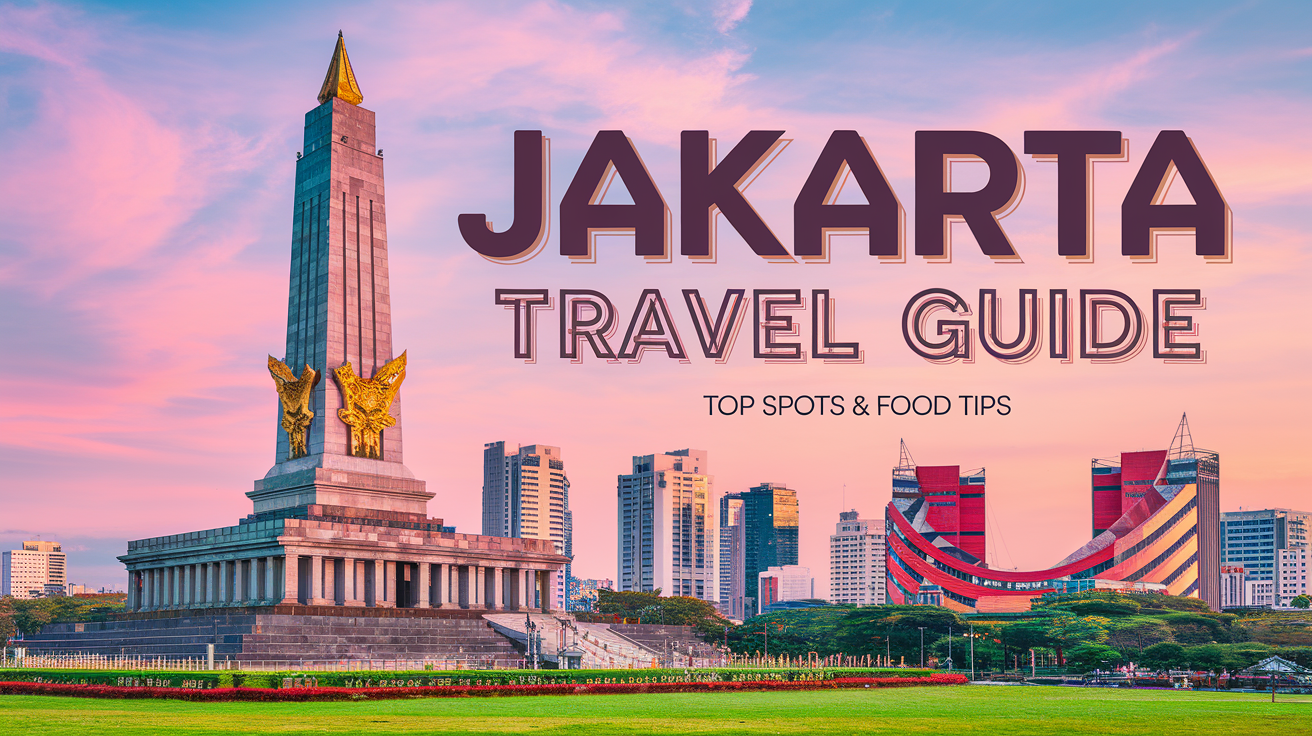Jakarta, Indonesia’s bustling capital, is a city that blends rich history, modern attractions, and vibrant culture. From historical landmarks to contemporary entertainment hubs, Jakarta offers something for everyone. Here’s the first part of our ultimate travel guide to the top 20 attractions in Jakarta.
1. National Monument (Monas)
Description: The National Monument, or Monas, is a 132-meter tower symbolizing Indonesia’s struggle for independence. Surrounded by a vast park, it offers a museum at its base and an observation deck at the top.
History: Built in 1961 under the orders of President Sukarno, Monas was designed to commemorate Indonesia’s independence and inspire patriotism.
Google Maps Link: National Monument (Monas)
Official Website: Monas Official
Ticket Prices:
– Observation Deck: IDR 20,000 (approx. $1.30 USD).
– Museum: Free.
Opening Hours: 8:00 am – 10:00 pm daily (last entry at 9:30 pm).
Travel Options:
– By MRT: Bundaran HI Station, followed by a short walk.
– By car: Ample parking available.
Nearby Restaurants:
– Café Batavia – Famous for its colonial ambiance and Indonesian-Dutch cuisine.
– Tugu Kunstkring Paleis – Known for traditional Indonesian dishes like rendang and nasi tumpeng.
Additional Tips: Visit early morning or evening for cooler weather. The observation deck provides stunning views of Jakarta’s skyline.
2. Taman Mini Indonesia Indah (Beautiful Indonesia Miniature Park)
Description: A cultural park showcasing Indonesia’s diverse traditions, Taman Mini features replicas of traditional houses, museums, gardens, and a cable car offering aerial views.
History: Opened in 1975, the park was the brainchild of former First Lady Siti Hartinah Suharto, who aimed to promote Indonesia’s rich cultural heritage.
Google Maps Link: Taman Mini Indonesia Indah
Official Website: Taman Mini Official
Ticket Prices:
– Entry Fee: IDR 25,000 (approx. $1.60 USD).
– Additional fees for attractions inside the park.
Opening Hours: 8:00 am – 5:00 pm daily.
Travel Options:
– By bus: TransJakarta buses connect to the park.
– By car: Ample parking available.
Nearby Restaurants:
– Bale Bengong TMII – Offers traditional Sundanese cuisine like grilled fish and nasi liwet.
– Ampera 2 Tak TMII – Known for its budget-friendly and authentic Indonesian dishes.
Additional Tips: Allocate at least half a day to explore. Wear comfortable shoes as the park is vast.
3. Kota Tua (Old Town)
Description: Jakarta’s Old Town is a historical area with colonial architecture, museums, and charming streets. It’s a hub of art, history, and vibrant local life.
History: Kota Tua was once the center of the Dutch East India Company’s trading operations, earning it the nickname “Batavia.” Many colonial-era buildings still stand today.
Google Maps Link: Kota Tua Jakarta
Ticket Prices: Free entry; museum fees vary.
Opening Hours: Open 24 hours; museums operate from 8:00 am – 5:00 pm.
Travel Options:
– By train: Jakarta Kota Station, a short walk to the Old Town.
– By bus: TransJakarta buses stop nearby.
Nearby Restaurants:
– Café Batavia – Serves Indonesian and Western dishes with colonial-era charm.
– Historia Food & Bar – Known for fusion dishes and cocktails.
Additional Tips: Visit the Fatahillah Museum, Wayang Museum, and Fine Art and Ceramic Museum for a deeper dive into the area’s history. The area is pedestrian-friendly, so explore on foot.
4. Ancol Dreamland (Taman Impian Jaya Ancol)
Description: Jakarta’s premier recreational park, Ancol Dreamland features beaches, a theme park (Dunia Fantasi), a water park (Atlantis Water Adventure), and an art market.
History: Opened in 1966, Ancol Dreamland was developed to provide leisure and entertainment for locals and tourists, evolving into one of Southeast Asia’s largest amusement complexes.
Google Maps Link: Ancol Dreamland
Official Website: Ancol Official
Ticket Prices:
– Park Entry: IDR 25,000 (approx. $1.60 USD).
– Dunia Fantasi: IDR 200,000 (approx. $13 USD).
– Atlantis Water Adventure: IDR 150,000 (approx. $10 USD).
Opening Hours: 6:00 am – 11:00 pm daily.
Travel Options:
– By bus: TransJakarta buses connect to Ancol.
– By car: Parking is available on-site.
Nearby Restaurants:
– Segarra Seaside Escape – Offers beachfront dining with seafood specialties.
– Bandar Djakarta Ancol – Famous for fresh seafood prepared to order.
Additional Tips: Allocate an entire day to explore. Bring swimwear if visiting the water park, and enjoy the sunset from the beach.
5. Istiqlal Mosque
Description: The largest mosque in Southeast Asia, Istiqlal Mosque is an architectural masterpiece and a symbol of Indonesia’s religious harmony, located near the Jakarta Cathedral.
History: Built between 1961 and 1978, the mosque commemorates Indonesia’s independence, with its name “Istiqlal” meaning “independence” in Arabic.
Google Maps Link: Istiqlal Mosque
Ticket Prices: Free entry (donations encouraged).
Opening Hours: 4:00 am – 10:00 pm daily.
Travel Options:
– By train: Juanda Station, a short walk to the mosque.
– By bus: TransJakarta buses stop nearby.
Nearby Restaurants:
– Bakoel Koffie Cikini – Offers traditional coffee and Indonesian snacks.
– Sate Khas Senayan – Known for its delicious satay and Indonesian classics.
Additional Tips: Visitors should dress modestly and may need to remove shoes before entering. Guided tours are available for those interested in the mosque’s architecture and history.
Travel Tips:
Best Time to Visit: Early mornings and late afternoons offer cooler weather for outdoor attractions like Monas and Kota Tua.
Transportation: Jakarta’s MRT and TransJakarta buses are efficient and affordable. Consider using ride-hailing apps for convenience.
Local Cuisine to Try: Don’t miss dishes like nasi goreng (fried rice), rendang (slow-cooked beef), and soto Betawi (Jakarta-style soup) at nearby eateries.
6. Jakarta Cathedral (Gereja Katedral Jakarta)
Description: A stunning neo-Gothic Roman Catholic cathedral located directly across from the Istiqlal Mosque, Jakarta Cathedral is a symbol of religious harmony and architectural beauty.
History: Built in 1901, the current cathedral replaced an earlier structure destroyed by fire. Its iconic spires and intricate interiors make it a must-visit landmark in Jakarta.
Google Maps Link: Jakarta Cathedral
Official Website: Jakarta Cathedral
Ticket Prices: Free entry.
Opening Hours: 6:00 am – 6:00 pm daily.
Travel Options:
– By train: Juanda Station, a short walk to the cathedral.
– By bus: TransJakarta buses stop nearby.
Nearby Restaurants:
– Batavia Café – Serves traditional Indonesian and international dishes.
– Soto Betawi Haji Husein – Famous for its Jakarta-style beef soup.
Additional Tips: Visitors should dress modestly and avoid visiting during service hours unless attending a mass. Combine your visit with a trip to the nearby Istiqlal Mosque.
7. Ragunan Zoo
Description: One of Southeast Asia’s oldest zoos, Ragunan Zoo is home to over 3,600 animals, including orangutans, Komodo dragons, and Sumatran tigers. The lush greenery makes it a great escape for families.
History: Established in 1864, Ragunan Zoo has evolved into a 140-hectare sanctuary focused on conservation and education.
Google Maps Link: Ragunan Zoo
Official Website: Ragunan Zoo
Ticket Prices:
– Adults: IDR 4,000 (approx. $0.25 USD).
– Children: IDR 3,000 (approx. $0.20 USD).
Opening Hours: 7:00 am – 4:00 pm daily (closed on Mondays).
Travel Options:
– By MRT: Ragunan Station, a short walk to the zoo.
– By car: Parking is available on-site.
Nearby Restaurants:
– Nasi Uduk Ibu Sum – Offers traditional rice dishes with fried chicken and sambal.
– Bakmi GM Ragunan – Known for its flavorful noodle dishes.
Additional Tips: Wear comfortable shoes as the zoo is extensive. Visit early to avoid crowds and see the animals during their most active hours.
8. Museum Nasional (National Museum of Indonesia)
Description: Also known as the “Elephant Building,” the National Museum houses an impressive collection of artifacts, including ancient statues, jewelry, and ethnographic displays from across Indonesia.
History: Established in 1868, the museum was founded to preserve Indonesia’s rich cultural heritage and is one of Southeast Asia’s oldest museums.
Google Maps Link: National Museum of Indonesia
Official Website: National Museum
Ticket Prices:
– Adults: IDR 5,000 (approx. $0.30 USD).
– Children: IDR 2,000 (approx. $0.15 USD).
Opening Hours: 8:30 am – 4:00 pm (Tuesday to Sunday). Closed on Mondays.
Travel Options:
– By MRT: Bundaran HI Station, followed by a short taxi ride.
– By bus: TransJakarta buses stop nearby.
Nearby Restaurants:
– Warung Nasi Ampera – Known for its budget-friendly Sundanese dishes.
– Gado Gado Bonbin – Famous for its Indonesian salad with peanut sauce.
Additional Tips: Allocate at least two hours to explore the museum fully. Guided tours are available and recommended for a deeper understanding of the exhibits.
9. Plaza Indonesia
Description: A luxurious shopping mall located in central Jakarta, Plaza Indonesia is home to high-end brands, fine dining restaurants, and entertainment options.
History: Opened in 1990, Plaza Indonesia was one of Jakarta’s first upscale malls and remains a symbol of modernity and sophistication in the city.
Google Maps Link: Plaza Indonesia
Official Website: Plaza Indonesia
Ticket Prices: Free entry; shopping and dining costs vary.
Opening Hours: 10:00 am – 10:00 pm daily.
Travel Options:
– By MRT: Bundaran HI Station, directly connected to the mall.
– By car: Parking is available on-site.
Nearby Restaurants:
– Paulaner Bräuhaus Jakarta – Serves German cuisine and house-brewed beer.
– AW Kitchen by Akira Watanabe – Offers Italian-Japanese fusion dishes.
Additional Tips: Combine your visit with a trip to Monas or Grand Indonesia Mall, located nearby. The mall is ideal for shopping, dining, or simply cooling off in air-conditioned comfort.
10. Thousand Islands (Kepulauan Seribu)
Description: A collection of idyllic islands located just off the coast of Jakarta, the Thousand Islands are perfect for beach lovers, snorkeling enthusiasts, and anyone seeking a tropical escape.
History: Once a trading hub, the islands are now a popular tourist destination, offering eco-resorts, pristine beaches, and marine biodiversity.
Google Maps Link: Thousand Islands
Ticket Prices:
– Ferry tickets: IDR 150,000 – 200,000 (approx. $10-13 USD) round trip.
– Accommodation costs vary by island.
Opening Hours: Open 24 hours; ferries operate from 7:00 am – 5:00 pm.
Travel Options:
– By ferry: Boats depart from Marina Ancol or Muara Angke Port.
Nearby Restaurants:
– Pulau Macan Eco Resort – Offers fresh seafood and local dishes.
– Sepa Island Restaurant – Known for its grilled fish and tropical drinks.
Additional Tips: Book ferry tickets and accommodation in advance. Bring sunscreen, swimwear, and snorkeling gear to make the most of your visit.
Travel Tips:
Best Time to Visit: Early mornings are ideal for attractions like the zoo and Thousand Islands to avoid crowds and enjoy cooler weather.
Transportation: Jakarta’s MRT and TransJakarta buses are efficient for reaching most attractions. Ride-hailing apps are also convenient.
Local Cuisine to Try: Don’t miss gado-gado, nasi uduk, and freshly grilled seafood at nearby eateries.
11. Ancol Art Market (Pasar Seni Ancol)
Description: A vibrant outdoor art market located in the Ancol Dreamland complex, this is a haven for art lovers. You’ll find local artists showcasing paintings, sculptures, crafts, and traditional performances.
History: Established in the 1970s, the Ancol Art Market was designed to promote Indonesian art and culture, providing a platform for local artists to sell and exhibit their work.
Google Maps Link: Ancol Art Market
Ticket Prices: Free entry; items for sale vary in price.
Opening Hours: 9:00 am – 7:00 pm daily.
Travel Options:
– By bus: TransJakarta buses to Ancol Dreamland.
– By car: Parking available within the Ancol complex.
Nearby Restaurants:
– Le Bridge Restaurant – Offers seaside dining with Western and Indonesian dishes.
– Bandar Djakarta Ancol – Famous for its fresh seafood.
Additional Tips: Visit during the weekend for live performances and artist demonstrations. Bring cash for purchasing art and souvenirs.
12. Glodok (Jakarta Chinatown)
Description: One of the largest Chinatowns in Southeast Asia, Glodok is a bustling area known for its traditional markets, Chinese temples, and street food.
History: Established during the Dutch colonial period in the 17th century, Glodok has remained a cultural hub for the Chinese-Indonesian community.
Google Maps Link: Glodok Chinatown
Ticket Prices: Free to explore.
Opening Hours: Open 24 hours; markets typically operate from 7:00 am – 5:00 pm.
Travel Options:
– By train: Jakarta Kota Station, followed by a short walk.
– By bus: TransJakarta buses stop nearby.
Nearby Restaurants:
– Bakmi Aboen – Known for its delicious Chinese-style noodles.
– Lindeteves Coffee – Offers traditional coffee and Chinese-Indonesian snacks.
Additional Tips: Don’t miss Vihara Dharma Bhakti, Jakarta’s oldest Buddhist temple. Visit early in the morning to explore the markets at their liveliest.
13. Fatahillah Museum (Jakarta History Museum)
Description: Located in the heart of Kota Tua (Old Town), the Fatahillah Museum is housed in the former city hall and showcases Jakarta’s history from prehistoric times to the colonial era.
History: Built in 1710, the building served as Batavia’s city hall during Dutch rule. It became a museum in 1974 and remains a significant cultural landmark.
Google Maps Link: Fatahillah Museum
Ticket Prices:
– Adults: IDR 5,000 (approx. $0.30 USD).
– Children: IDR 2,000 (approx. $0.15 USD).
Opening Hours: 9:00 am – 3:00 pm (Tuesday to Sunday). Closed on Mondays.
Travel Options:
– By train: Jakarta Kota Station, a short walk to the museum.
– By bus: TransJakarta buses stop nearby.
Nearby Restaurants:
– Café Batavia – Famous for its colonial ambiance and Indonesian-Dutch dishes.
– Historia Food & Bar – Offers fusion cuisine and a relaxed atmosphere.
Additional Tips: Allocate 1-2 hours to explore the museum’s exhibits. Combine your visit with other attractions in Kota Tua, like the Wayang Museum and Fine Art and Ceramic Museum.
14. Gelora Bung Karno Stadium (GBK)
Description: Indonesia’s largest stadium and a major venue for national and international sports events, concerts, and cultural activities. The surrounding park offers jogging tracks and recreational areas.
History: Built in 1962 for the Asian Games, the stadium has since become a symbol of national pride and has hosted numerous historic events.
Google Maps Link: Gelora Bung Karno Stadium
Ticket Prices:
– Entry to the park: Free.
– Event ticket prices vary.
Opening Hours: Park: 6:00 am – 10:00 pm. Event timings vary.
Travel Options:
– By MRT: Senayan or Istora Mandiri Station, a short walk to GBK.
– By car: Parking available nearby.
Nearby Restaurants:
– Plataran Senayan – Offers upscale Indonesian dining in a lush setting.
– Bakso Lapangan Tembak Senayan – Famous for its meatball soup.
Additional Tips: Check the schedule for live events. The jogging track and park are ideal for morning or evening walks.
15. Setu Babakan (Betawi Cultural Village)
Description: A cultural village dedicated to preserving and showcasing Betawi traditions, including traditional houses, crafts, music, and cuisine.
History: Established in 2000, Setu Babakan serves as a living museum for Betawi culture, offering a glimpse into Jakarta’s indigenous heritage.
Google Maps Link: Setu Babakan
Ticket Prices: Free entry; activity costs vary.
Opening Hours: 9:00 am – 5:00 pm daily.
Travel Options:
– By car: 45-minute drive from central Jakarta.
– By bus: TransJakarta buses connect to nearby terminals, followed by a taxi ride.
Nearby Restaurants:
– Warung Betawi Haji Mamat – Known for soto Betawi (Jakarta-style beef soup).
– Nasi Uduk Kebon Kacang – Offers Betawi-style coconut rice dishes.
Additional Tips: Visit during weekends for cultural performances and traditional craft demonstrations. Try Betawi dishes like kerak telor (savory egg pancake) and bir pletok (Betawi herbal drink).
Travel Tips:
Best Time to Visit: Visit outdoor attractions like Glodok and Setu Babakan in the morning or late afternoon to avoid the midday heat.
Transportation: Use MRT and TransJakarta buses for convenient travel. Ride-hailing apps are ideal for areas not directly accessible by public transport.
Local Cuisine to Try: Don’t miss kerak telor, soto Betawi, and freshly grilled seafood at nearby eateries.
16. Taman Suropati
Description: A peaceful park in central Jakarta, Taman Suropati is a green oasis surrounded by colonial-style houses. It’s popular for morning jogs, yoga, and art exhibitions.
History: Originally named Burgemeester Bisschopplein during the Dutch colonial era, it was renamed Taman Suropati after a Javanese national hero.
Google Maps Link: Taman Suropati
Ticket Prices: Free entry.
Opening Hours: Open 24 hours.
Travel Options:
– By train: Cikini Station, a 10-minute walk.
– By car: Parking is available nearby.
Nearby Restaurants:
– Lara Djonggrang – Known for its upscale Indonesian dishes and cultural ambiance.
– Bunga Rampai – Serves refined Indonesian cuisine in a historic setting.
Additional Tips: Visit early in the morning or late in the afternoon for cooler weather. The park is particularly lively on weekends.
17. Pelabuhan Sunda Kelapa (Sunda Kelapa Harbor)
Description: A historic port featuring traditional wooden ships (phinisi) used for trade since the Dutch colonial era. It’s a great spot to explore Jakarta’s maritime history.
History: Sunda Kelapa was a bustling trading port in the 13th century and played a key role during the Dutch East India Company era. Today, it remains an active port for smaller vessels.
Google Maps Link: Sunda Kelapa Harbor
Ticket Prices: Free entry; guided tours cost approximately IDR 50,000 (approx. $3 USD).
Opening Hours: 8:00 am – 6:00 pm daily.
Travel Options:
– By car: A 30-minute drive from central Jakarta.
– By bus: TransJakarta buses connect to Kota Tua, followed by a short taxi ride.
Nearby Restaurants:
– Batavia Marina – Offers seafood with a harbor view.
– Warung Mak Dower – Known for its authentic Betawi dishes like soto Betawi.
Additional Tips: Hire a guide or a local boatman to learn more about the port’s history. Wear comfortable shoes for walking around the area.
18. Menteng Park (Taman Menteng)
Description: A modern urban park featuring a jogging track, basketball courts, playgrounds, and lush greenery. It’s a popular spot for families and fitness enthusiasts.
History: Built on the site of Jakarta’s former Persija soccer stadium, the park was developed as part of an urban renewal project in 2007.
Google Maps Link: Menteng Park
Ticket Prices: Free entry.
Opening Hours: Open 24 hours.
Travel Options:
– By train: Gondangdia Station, a 15-minute walk.
– By car: Parking is available nearby.
Nearby Restaurants:
– Sate Khas Senayan Menteng – Famous for its satay and traditional Indonesian meals.
– Warung Kopi Tak Kie – Known for its traditional coffee and simple local snacks.
Additional Tips: The park is especially lively during the weekends with pop-up food stalls and street performances. Early mornings are best for a peaceful visit.
19. Grand Indonesia Mall
Description: One of Jakarta’s largest and most luxurious malls, Grand Indonesia offers high-end shopping, entertainment, and dining options spread across two wings connected by a skybridge.
History: Opened in 2008, the mall has become a symbol of Jakarta’s modernity and serves as a one-stop destination for locals and tourists alike.
Google Maps Link: Grand Indonesia Mall
Official Website: Grand Indonesia
Ticket Prices: Free entry; shopping and dining costs vary.
Opening Hours: 10:00 am – 10:00 pm daily.
Travel Options:
– By MRT: Bundaran HI Station, directly connected to the mall.
– By car: Parking is available on-site.
Nearby Restaurants:
– Social House – Offers global cuisine with stunning views of the Jakarta skyline.
– Paulaner Bräuhaus Jakarta – Serves German food and house-brewed beer.
Additional Tips: Combine your visit with a trip to Plaza Indonesia or Monas, located nearby. The Fountain Atrium hosts live music and events during weekends.
20. Kampung Kemang
Description: A trendy neighborhood in South Jakarta, Kampung Kemang is famous for its vibrant nightlife, boutique shops, art galleries, and international dining options.
History: Once a quiet Betawi village, Kemang has evolved into a cosmopolitan hub while still retaining its cultural charm.
Google Maps Link: Kampung Kemang
Ticket Prices: Free to explore; dining and shopping costs vary.
Opening Hours: Open 24 hours; restaurant and bar timings vary.
Travel Options:
– By car: A 30-minute drive from central Jakarta.
– By taxi or ride-hailing apps: The easiest way to navigate this area.
Nearby Restaurants:
– The Duck King Kemang – Known for its Chinese cuisine and dim sum.
– Antipodean Café – Offers Australian-style brunch and coffee.
Additional Tips: Visit during the evening for the best nightlife experience. Don’t miss the art galleries and pop-up markets for unique finds.
Travel Tips:
Best Time to Visit: Morning or late afternoon for outdoor attractions like Taman Suropati and Menteng Park. Evening is ideal for Kampung Kemang and Grand Indonesia Mall.
Transportation: Jakarta’s MRT and TransJakarta buses are convenient for most destinations. For neighborhoods like Kemang, ride-hailing apps are the best option.
Local Cuisine to Try: Sample satay, Betawi-style dishes, and international cuisine at nearby restaurants.




